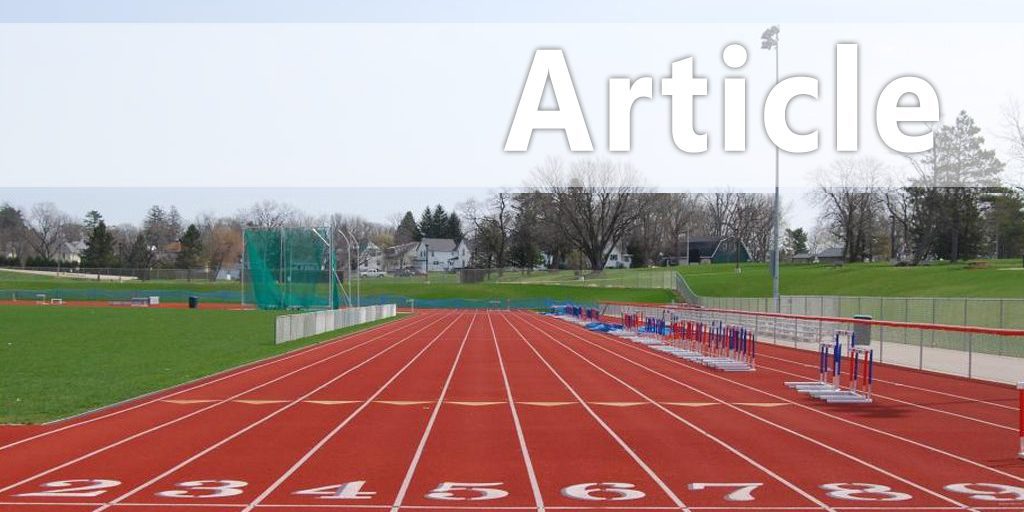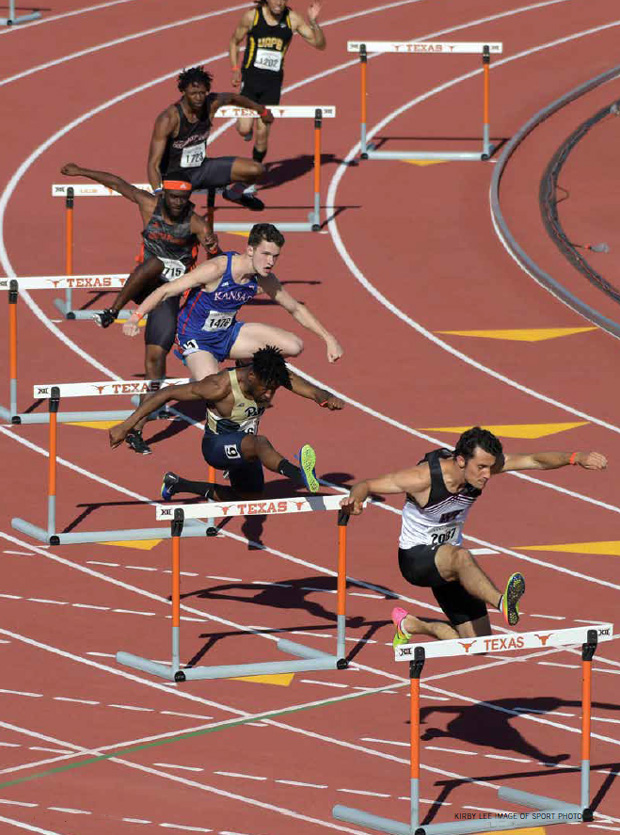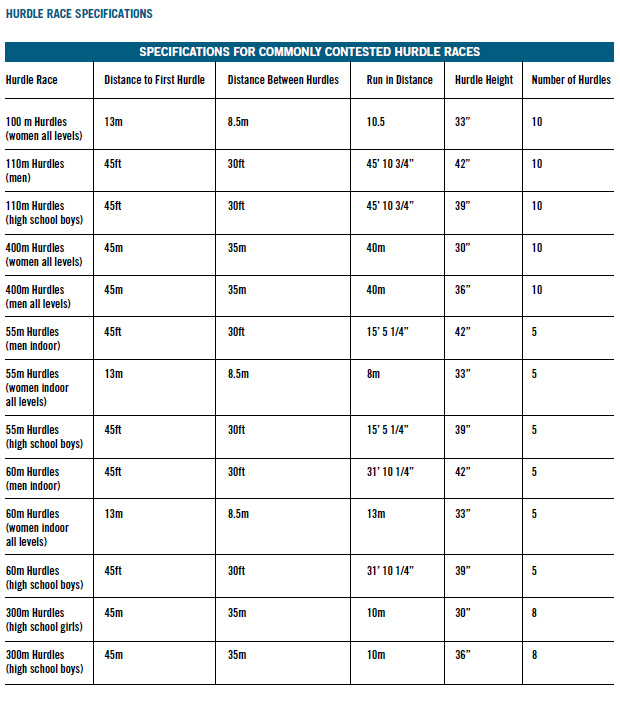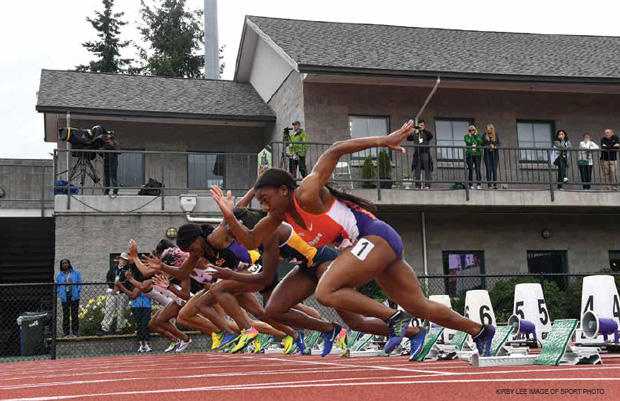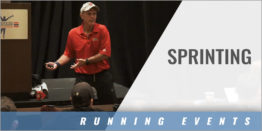| The Biomechanics of Hurdling |
| Originally Published in: Techniques Magazine
Provided by: USTFCCCA IN THIS CHAPTER TAKEN FROM THE SPRINTS, HURDLES, RELAYS SPECIALIST CERTIFICATION COURSE CURRICULUM, THE TECHNICAL ASPECTS OF THE HURDLE EVENTS ARE ADDRESSED. AN OVERVIEW OF HURDLING GOALS OF HURDLE TRAINING. Every hurdle race consists of a start, an approach to the first hurdle, rhythmic running over and between the remaining hurdles, and a sprint to the finish after the final hurdle is cleared. Hurdle training then consists of the following components: Teaching and Developing the Start. This is done by improving starting mechanics and developing related physical performance components. Teaching Hurdle Clearance Mechanics. This is done by teaching and drilling the ability to execute movements of the preparation and takeoff, lead leg and trail leg, and landing proficiently and consistently at race speeds. Teaching and Developing the Approach to the First Hurdle. This is done by improving technique, acceleration capabilities and related physical performance components. Teaching and Improving the Ability to Run Hurdles at Maximal Velocity. This is done by improving technique, hurdle specific absolute speed abilities and related physical performance components. Developing Resistance to Deceleration. This is done by improving hurdle specific speed endurance and related physical performance components. HURDLES AND SPRINTS The hurdler should be a proficient sprinter, and hurdle races should be considered as sprint races, with modifications of sprint mechanics used to negotiate the hurdles. The hurdle events should not be considered a dumping ground for failed or subpar sprinters. A great portion of the hurdler's training program should resemble that of the sprinter.
THE BIOMECHANICS OF HURDLE CLEARANCE For coaching purposes, the hurdle clearance should be considered as a modification of running mechanics. Deceleration and flight time over hurdles should be minimized to maximize performance. THE HURDLE TAKEOFF Preparation. The penultimate step prior to takeoff should not show radical lowering or other major deviations from normal, inter-hurdle running mechanics. The leg that executes the penultimate step subsequently becomes the lead leg, so poor or radical preparation mechanics will affect lead leg movements. Actively displacing from the penultimate step produces elastic responses in the hip flexors that subsequently assist the lead leg in its forward movement. Takeoff Location. The takeoff foot should contact the surface approximately 1.80 to 2.00 meters away from the hurdle for women. The takeoff foot should contact the surface approximately 2.10 to 2.20 meters away from the hurdle for men. Some variance should be expected, since leg length, speed levels and skill levels affect this distance.
Grounding the Takeoff Step. The takeoff step should be actively grounded on the ball of the foot, almost directly under the body's center of mass. This step often appears shorter than the previous steps, and for this reason is commonly referred to as a cut step. The shin angle at touchdown should be vertical. The correct grounding of this step minimizes deceleration, prevents excessively high takeoff trajectories, and sets up the subsequent movements of hurdle takeoff, clearance, and landing. Hip Extension. The takeoff is created by a forceful extension of the hip, displacing the hurdler's body at a low trajectory. Displacement. Significant displacement of the body should occur during support. This should result in the hurdler's body moving significantly beyond the takeoff foot before flight is achieved. This displacement should be initiated in the core of the body (the trunk and hips), as opposed to the limbs (particularly the lead leg). This displacement also develops an elastic response in the hip flexors of the takeoff leg that is essential to efficient trail leg mechanics. Body Lean. Forward body lean may be needed to aid clearance, but this lean should not result in disturbed postural alignment. THE LEAD LEG Support and Flight. Movements of the lead leg begin during the support phase of takeoff, but are completed after the hurdler has left the ground. Pelvic Origination. The lead leg's forward movement is initiated in the pelvis, as pelvic oscillations are amplified at takeoff and the pelvis displaces forward during the support phase of takeoff. This helps to conserve posture in flight, counters the forward rotation associated with the displacement and improves the efficiency of the hurdle clearance. The subsequent extension of the lead leg's joints should occur proximally to distally. The Upper Leg. The lead leg knee is directed toward the hurdle. Recovery height is high, as angular velocity is transferred to the lower leg as the thigh changes direction. The Lower Leg. The blocking of the thigh at the completion of its flexion results in another transfer of angular momentum, extending the knee, placing the lower leg in position for clearance, and completing extension of the lead leg. The knee extends only after the hip flexion is complete. The knee should not extend completely; and complete extension of the knee typically results from deceleration at takeoff. The Arms. Countering the movements of the lead leg requires adjustments in arm movements, particularly the arm opposite the lead leg. Velocities and radii of the lead leg and arm must coincide to maintain proper balance. Improper arm actions are typically indicative of poor takeoff or lead leg mechanics. The Landing. The hurdle landing should occur close to the hurdle, with the body's center of mass over the landing foot. Difficulties here are always related to takeoff and should be addressed by cause and effect coaching. THE TRAIL LEG Support and Flight. Movements of the trail leg are set up during the support phase of takeoff, but are performed and completed after the hurdler has left the ground. Setting Up the Trail Leg. The takeoff leg subsequently becomes the trail leg, so movements at takeoff have great effect upon the trail leg action. A properly timed and effective recovery of the trail leg is dependent upon displacement of the body beyond the foot at takeoff and the resulting elastic response generated in the hip flexors of that leg. This elastic response contributes to the speed of the trail leg action. For this reason, hurdlers who take off from a position too close to the hurdle often have difficulties with the trail leg because this proximity to the hurdle prevents complete displacement and the establishment of this elastic response. Trail Leg Movements. Once the takeoff foot loses ground contact, the leg is vigorously pulled forward and upward, abducting and flexing the hip. This allows the heel of the trail leg to fold tightly near the buttocks as angular momentum is transferred to the lower leg, shortening the radius of the movement, and speeding the movement. Trail Leg Positions. Throughout the trail leg movement, the knee of that leg should remain higher than the corresponding ankle. Improper positions cause unsettling torques and misalignments in the hips, and are generally indicative of a poor takeoff. The hurdler must evert the foot to allow clearance. Upper Body Changes. Modifications occur in upper body countering in order to balance the modified lower body activity. This results in a wider sweep of the lead (trail leg side) arm to counter the wider path of the trail leg. While a shorter radius of this arm is faster, care must be taken. A certain amount of mass must be countered, and an excessively short radius of this arm may introduce imbalance. The Landing. Upon completion of clearance, the trail leg moves downward to resume sprinting. As it moves downward, the lower leg should be kept in alignment as the hip drives it toward the ground, so that this step grounds under the body's center of mass. TECHNICAL CONSIDERATIONS FOR THE SPRINT HURDLES Practical Observations for the Sprint Hurdles. The sprint hurdles require extremely high levels of speed, strength, power, coordination and mobility. The sprint hurdle event should always be considered a sprint event when in coaching practices, and the hurdler should not be selected from candidates of failed sprinter status. Being able to achieve levels and patterns of acceleration and maximal velocity similar to high level sprinters are key elements of successful sprint hurdling. THE APPROACH TO THE FIRST HURDLE GOALS OF THE APPROACH. The approach to the first hurdle should accomplish these goals: Acting as an Acceleration Phase. The approach to the first hurdle should constitute all or part of an acceleration phase, so that momentum needs are met. Permitting an Accurate Takeoff. The approach to the first hurdle should place the hurdler in an accurate location from which to execute the hurdle clearance, so that proper technique can be used and time preserved. Positioning the Body for Takeoff. The approach to the first hurdle should place the body in the correct physical positions and motor environment to execute the mechanics of hurdle clearance correctly. STEP NUMBER The Eight Step Approach. The approach to the first hurdle is usually covered in eight steps. The eight step approach is appropriate for the accelerative capabilities of most athletes, permits attainment of high velocities earlier and better prepares the hurdler for the high stride frequencies needed later when running between the hurdles. Some exceptional athletes can reach the first hurdle in seven steps, but this makes the transition to the quicker rhythm of interhurdle running quite difficult. Our discussion will be limited to the eight step approach. This eight step approach mandates placing the takeoff leg forward in the blocks. Eight vs. Seven. At the elite levels, several hurdlers use a seven step approach to the first hurdle rather than the more traditional eight steps. Seven step approaches require less alteration of standard drive phase mechanics, producing the obvious advantage of enhanced momentum development. However, seven step approaches also result in a slower stride cadence. This may result in difficulty in making the conversion to the faster cadence needed between the succeeding hurdles. For this reason, seven step approaches should be reserved for elite level performers, and the ability to reach the proper takeoff location in seven steps should not be considered the only prerequisite for using this style. Keeping long-term development in mind, there are definite advantages to mastering the eight step approach in training and competition, prior to even considering a conversion to the seven step approach Balancing Frequency and Displacement. With advanced and intermediate level hurdlers, displacement must be decreased and stride frequency increased in order to shorten strides enough to arrive at the correct takeoff location. Teaching hurdlers to drive for the first three to four steps, and quicken the stride cadence for the remaining steps is common coaching practice. Using stride length/frequency relationships to adjust takeoff locations is common coaching practice. Modifications of the Acceleration Process. The approach to the first sprint hurdle should demonstrate all of the characteristics of acceleration. However, the proximity of the first hurdle causes several modifications of acceleration when compared to sprint events. Compromised Amplitude and Displacement. Amplitudes of movement and the dis-placement associated with each step are decreased with higher level hurdlers. High amplitudes of movement create longer strides and place the hurdler too close to the barriers to take off correctly. This is especially the case with advanced hurdlers. Altered Body Angle Progression. The progression of body angles from a position of forward lean to an upright position must occur at a faster rate, so that the hurdler can be in an upright position to clear the first barrier. Altered Stride Frequencies. Stride frequencies are higher, because this added frequency shortens stride lengths and prevents the hurdler from getting too close to the barriers. This is especially the case with advanced hurdlers.
INTERHURDLE RUNNING Step Number. For high levels of performance, three steps should be taken between hurdles in the sprint hurdle events. Vertical Pushing. Push off angles, as indicated by the shin angles associated with touchdown of each step, are primarily vertical, as in maximal velocity sprinting. Excessively acute shin angles affect takeoff trajectories, and the resultant instability disrupts takeoff and lead leg mechanics. This commonly results in striking hurdles. Modifications of Maximal Velocity Mechanics. Sprinting between the hurdles in the 100 and 110 meter hurdle races usually requires a modification of maximal velocity mechanics. Young athletes or athletes with less speed may be able to run between the hurdles with step lengths that vary little from normal sprinting. However, in intermediate and advanced hurdlers, there is a need to decrease stride length between the hurdles in order to fit the needed three steps between the hurdles without getting to close to the hurdles to takeoff properly. This results in several modifications of maximal sprinting. Diminished Amplitudes. Amplitudes of movement, particularly in the hips, are decreased to shorten stride length. Increased Frequency. Stride frequency is increased to shorten stride length. Recovery Heights. Recovery heights are decreased slightly. As maximal velocity is achieved (normally between hurdles five, six, and sometimes seven), quicker, shuffle-like steps maintain the correct takeoff distances and aid the transition from maximum hurdle velocity to the maintenance phase. The inability to address top speed hurdle rhythms causes the hurdler to takeoff too close to the hurdles, resulting in increased vertical takeoffs or hurdle hits. TECHNICAL CONSIDERATIONS FOR THE LONG HURDLES Race Demands. The long hurdle races demand the ability to sprint well at the 200 and 400 meter distances, while possessing endurance capacities similar to those of an 800 meter runner. The long hurdler must also possess the ability to negotiate hurdles efficiently, using either leg as a lead leg. The set distances between hurdles reflect the need for flexibility in the stride pattern and lead leg choice. Hurdle Clearance Changes. The takeoff and landing are less aggressive than in the sprint hurdle event, and the getaway step are more relaxed, permitting the energy conservation needed in the longer event. Economy of effort is an important attribute in successful long hurdling. Hurdle Stride Length. The hurdle stride usually covers approximately 3 meters with 63 percent of that stride before the hurdle and the remaining 37 percent occurring after the hurdle. The getaway stride is longer than that shown in the sprint hurdles. Pace. Analysis of both the 400 meter and 400 meter hurdle races reveals similar race rhythms and suggests the 400 hurdler should use a similar approach to race pace. BIOMECHANICAL ANALYSIS OF THE LONG HURDLES THE APPROACH TO THE FIRST HURDLE Goals of the Approach. The approach to the first hurdle should accomplish these goals: Acting as an Acceleration Phase. A portion of the approach to the first hurdle should constitute all or part of an acceleration phase, so that momentum needs are met. Permitting an Accurate Takeoff. The approach to the first hurdle should place the hurdler in an accurate location from which to execute the hurdle clearance, so that proper technique can be used and time preserved. Positioning the Body for Takeoff. The approach to the first hurdle should place the body in the correct physical positions and motor environment to execute the mechanics of hurdle clearance correctly. Step Number. Men take 19-23 steps to the first hurdle while women use 22-25 step approaches. The Acceleration Phase in the 400 Meter Hurdles. In the long hurdle races, the acceleration phase should extend at least halfway to the first hurdle. This establishes adequate momentum values so that the remainder of the race can be run efficiently. Unlike in the sprint hurdle races, the greater distance to the first hurdle allows uncompromised acceleration phase mechanics. Balancing Frequency and Displacement. When developing consistency and accuracy in the approach, using stride length/ frequency relationships to adjust takeoff locations is common coaching practice. INTERHURDLE RUNNING Step Number. It is typical to establish some type of stride pattern as part of the race plan for the 300 or 400 hurdles. At high levels, men take 12-15 steps between the hurdles, while women use a 14-19 step rhythm. Step patterns frequently change in the latter stages of the race as fatigue sets in. The great distance between the barriers in these races permits normal sprinting between the hurdles, with no significant changes in mechanics except in cases of extreme steering. Planning the Race. The stride pattern plan should be formed, depending upon the athlete's ability level and performance in training. This plan should still be somewhat flexible since fatigue levels at the end of the race are unpredictable. Steering. The hurdler must be able to adjust stride lengths at times in order to takeoff from the proper location. To prevent deceleration, these adjustments should be minimal. Visually locating the next hurdle early assists here. The long hurdler, while on the curve, can use lateral movements in the lane in order to steer to the correct takeoff location. Alternating. The ability to hurdle using either leg as a lead leg is an essential skill. Being able to alternate in this way makes steering to the proper takeoff location much easier. Boo Schexnayder was primarily responsible for the content of the majority of the Track & Field Academy's course curriculum including this excerpt the various Specialist Certification course texts. Gary Winckler also contributed to the development of the Sprints, Hurdles, Relays curriculum. |
